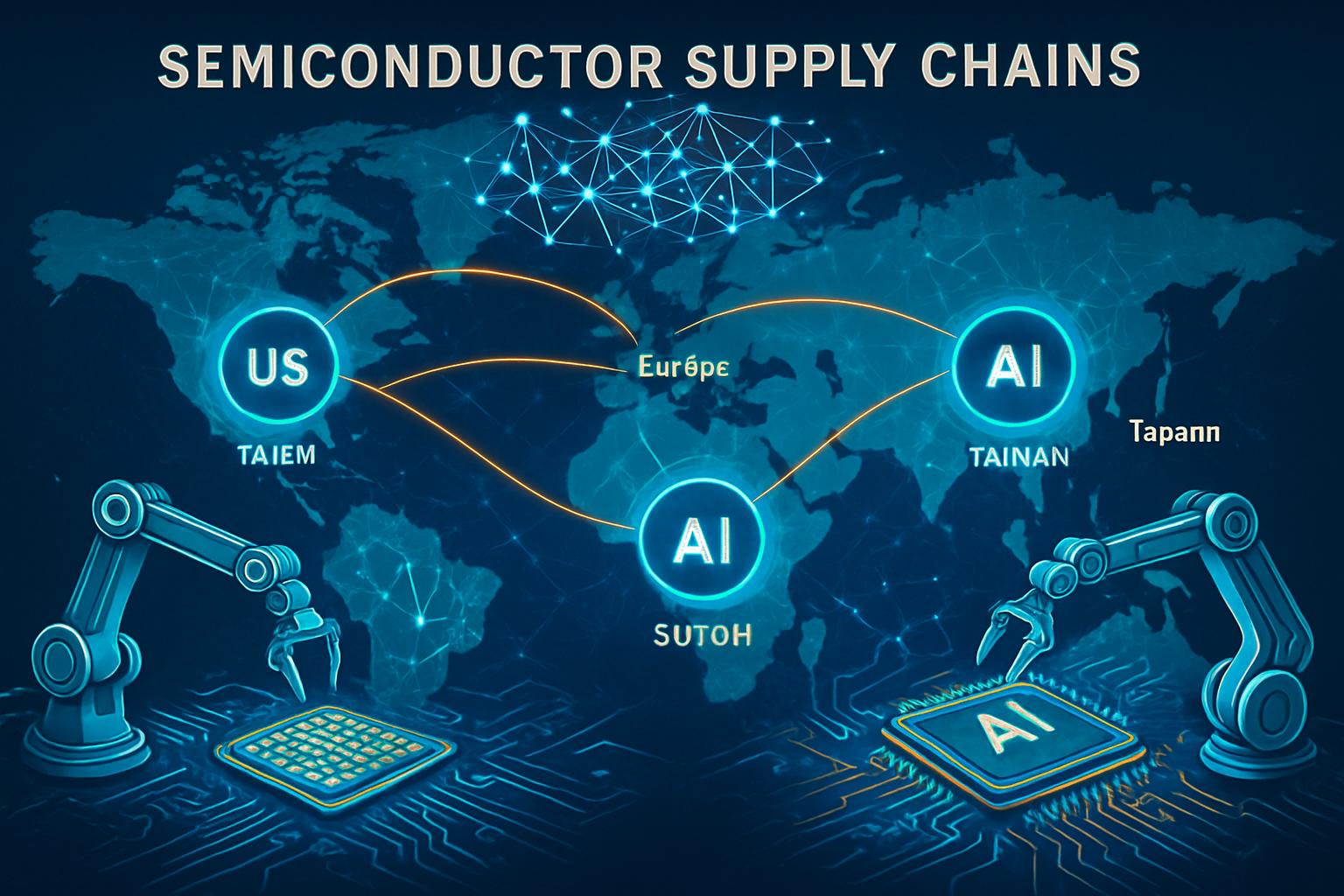
AI CERTs
14 hours ago
AI Semiconductor Surge Reshapes 2025 Chip Landscape
The AI Semiconductor Surge dominates every boardroom discussion. Global chip revenue is climbing toward a record as hyperscalers race to expand AI clusters. Consequently, demand for GPUs, networking silicon, and high-bandwidth memory keeps stretching supply lines. However, robust growth brings fresh strategic questions for executives tracking semiconductor analytics and procurement budgets.
Market watchers note 25% year-to-date revenue expansion. Meanwhile, SIA data for April and May show near 20% year-on-year monthly gains. These signals reinforce the AI Semiconductor Surge narrative and hint at a $700-730 billion market size for 2025.

Key Demand Drivers Explained
Several forces propel the AI Semiconductor Surge. Firstly, hyperscalers keep refreshing training clusters with NVIDIA Blackwell GPUs and custom XPUs. Additionally, SK Hynix and Micron report sold-out HBM batches that command premium prices. Moreover, ultra-fast switches such as Broadcom’s Tomahawk link tens of thousands of accelerators with minimal latency.
Edge deployments add incremental volume as Arm and Qualcomm release power-efficient AI chips for smartphones and vehicles. In contrast, traditional PC demand remains subdued. Consequently, the revenue mix tilts sharply toward data-center parts that carry higher margins.
These drivers confirm enduring momentum. Furthermore, they illustrate how semiconductor analytics can quantify each segment’s contribution.
The strong pull from hyperscalers defines the present era. Next, we examine the numbers behind this growth.
Global Market Data Snapshot
Recent SIA readings underscore impressive velocity. April 2025 sales reached $57 billion, rising 22.7% year over year. Subsequently, May delivered $59 billion, marking 19.8% growth. Meanwhile, the WSTS spring forecast pegs full-year revenue at $700.9 billion, up 11.2%.
Analyst firm Gartner echoes that outlook. Their preliminary 2024 tally hit $626 billion, and they expect roughly $705 billion this year. Furthermore, Gartner flags GPUs and memory as the fastest-growing sub-segments.
- April YoY growth: 22.7%
- May YoY growth: 19.8%
- Projected 2025 revenue: $700-730 billion
- Data-center share: second-largest semiconductor market
These numbers validate the AI Semiconductor Surge story. Nevertheless, deeper semiconductor analytics help pinpoint which firms benefit most.
The figures show sustained double-digit gains. However, corporate performance varies, as the next section reveals.
Leading Corporate Beneficiaries List
NVIDIA remains the emblem of this AI Semiconductor Surge. CEO Jensen Huang recently said demand for Blackwell chips is “insane.” Furthermore, Broadcom posted AI semiconductor revenue of $4.4 billion in Q2 fiscal 2025, soaring 46%.
Memory suppliers also ride the wave. SK Hynix and Micron report tight HBM capacity, with pricing power intact. Additionally, TSMC books multiyear orders for advanced packaging that bundles GPUs with HBM stacks.
Networking gains similar momentum. Broadcom’s Spectrum switches and NVIDIA’s InfiniBand adaptors connect burgeoning clusters. Moreover, Intel, AMD, and a cadre of startups pursue custom accelerators targeting specific workloads.
Collectively, these companies exemplify how an agile AI hardware supply chain converts demand spikes into revenue. Nevertheless, policy frameworks and investment incentives further shape the field.
Corporate winners illustrate immediate upside. Subsequently, policy dynamics influence the medium-term outlook.
Policy And Capex Forces
Government initiatives amplify the AI Semiconductor Surge. The U.S. CHIPS Act, Europe’s Chips Act, and Asian programs funnel billions into new fabs. Consequently, equipment suppliers such as ASML receive record EUV tool orders.
Hyperscalers complement public funding with unprecedented capital expenditure. Amazon, Microsoft, and Google each plan multibillion-dollar outlays for AI data centers. Moreover, Broadcom pairs hardware with VMware software to boost recurring revenue.
However, export controls inject uncertainty. U.S. restrictions on advanced AI accelerators sold to China compel vendors to reconfigure product lines. Nevertheless, diversified geographic demand partly offsets those limitations.
Policy spending extends the cycle, while controls create selective friction. Therefore, a resilient AI hardware supply chain becomes vital.
Incentives spur capacity, yet supply bottlenecks persist. Consequently, risk management moves into focus.
Critical Supply Chain Risks
Supply tightness tops executive worry lists. HBM modules face year-long lead times, and advanced packaging capacity remains constrained. Additionally, ASML’s backlog for EUV systems stretches several years.
Furthermore, concentration of demand amplifies volatility. Four hyperscalers account for a large share of AI chip purchases. In contrast, any pause in their spending could ripple through the entire sector.
Geopolitical tension heightens complexity. Export controls and potential tariffs may redirect investment into local alternatives, fragmenting the AI hardware supply chain.
These risks underscore why robust semiconductor analytics are essential for capacity planning. Moreover, professionals can deepen policy understanding through the AI + Policy Maker Certification.
Risks threaten timelines, yet informed strategies mitigate impacts. The next section presents actionable guidance.
Practical Actionable Insights Ahead
Executives should diversify supplier bases across regions and nodes. Additionally, pre-booking HBM and packaging capacity secures delivery windows. Moreover, tighter alignment between silicon design and software workloads optimizes total cost.
Firms should integrate near-real-time semiconductor analytics dashboards. Consequently, leadership can monitor inventory, pricing, and geopolitical developments. In contrast, static quarterly reviews lack agility.
Partnerships with research institutes can de-risk technology transitions. Furthermore, cross-training engineers on multiple foundry processes builds resilience within the AI hardware supply chain.
These steps improve readiness for future shocks. Therefore, companies position themselves to benefit from the continuing AI Semiconductor Surge.
Strategic actions create buffers and upside. Finally, we evaluate long-term prospects.
Conclusion And Forward Outlook
The AI Semiconductor Surge has shifted the entire industry trajectory. Global sales near $730 billion appear attainable, powered by data-center accelerators, high-bandwidth memory, and networking silicon. Moreover, policy incentives and hyperscaler capex sustain multi-year growth, even as export controls and supply bottlenecks loom.
Consequently, companies that harness semiconductor analytics, fortify the AI hardware supply chain, and pursue targeted learning—such as the AI + Policy Maker Certification—will capture disproportionate value. Nevertheless, vigilance remains crucial because concentrated demand and geopolitical shifts can swiftly alter forecasts.
Industry leaders should act now. Explore advanced certifications, deepen market intelligence, and proactively secure supply. The next growth wave has already begun; preparation determines who prospers.



